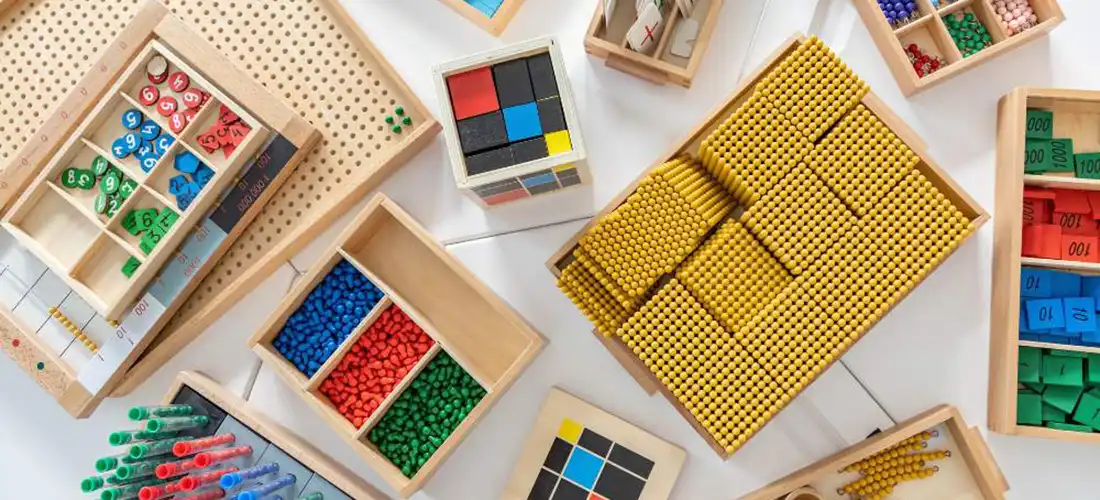The different academic areas within a Montessori classroom are keys that unlock a world of learning, growth, and understanding for students. Social/emotional, physical, and cognitive development (i.e.; the whole child) are all targeted within these areas. The math and language materials produce many tangible results, such as the concrete understanding of place value and the decimal system, recognition of sounds and the eventual ability to read. The skills needed for mastery of these activities are reinforced and encouraged throughout the entire classroom.
Understanding within the math and language areas is interdependent upon how the practical life, sensorial, and cultural areas build upon one another at various sensitive periods of learning. Throughout this blog you will be shown the importance of the hands-on materials that lead to the ability to visualize and comprehend abstract math approaches, and gain a thorough understanding of the language found in the world around us each day.
Montessori’s Abstract Approach to Mathematics
Some individuals think that math is instinctively feared or disliked by children, however, Montessori classrooms prove otherwise. There are four main tendencies at work at this time in a young child’s mind, which are directly associated with mathematics and guide the mathematical mind. These tendencies are those of
-
-
- Order
- Exactness
- Abstraction
- Calculation
-
Montessori materials are geared towards meeting and fulfilling these natural tendencies within the child. Practical life exercises address order, progression, sequencing, exactness, eventual abstraction, and calculation. Sensorial works lay a foundation for the development of the mathematical mind as they are precise, exact, and embody something that is abstract; they aid in the development of thinking from the concrete to the abstract, which is the same course taken when teaching mathematics in Montessori.

The math area in a Montessori classroom begins by working with the numbers 1-10 and the concept of zero, thus forming an understanding of the base ten system. Sandpaper numerals, number rods, spindle boxes, cards and counters, and memory games all strengthen the knowledge of and comfort with 0-10. Once this foundational building block is firmly ensconced in the student’s understanding, the decimal system is introduced. Unit beads, ten bars, hundred squares, and thousand cubes are held and compared, providing a tactile, as well as aesthetic representation of what is commonly presented in other teaching methods in an abstract way. Decimal cards are then introduced and paired with the bead material to solidify the concept of association of symbol and quantity. Arithmetical operations are introduced once the concept of the decimal system is firmly understood. And as with any concept or subject area taught in a Montessori classroom, each child is followed and learns at their own pace.
Montessori’s Appreciation of Language
The language area is full of beauty and wonder. Language itself is a means to express thoughts, share culture, and pass along wisdom. It is a creative act with beauty, form, and structure. Every area within a Montessori classroom is alive with language, fulfilling the needs of the sensitive period in which the child is immersed. Montessori uses a language approach which is holistic; it is based on listening, speaking, reading, and writing, and is rooted in an individual’s experience.


The sensorial area holds many keys to future reading and writing skills. The student’s eye is trained to distinguish form, and perceptual and manipulative skills are sharpened through the use of the pink tower, constructive triangles, geometric solids, and geometric cabinet. Several materials emphasize shape, which is indirect preparation for reading and writing skills, as shape is the defining characteristic of each letter of the alphabet. Strong listening skills, which are imperative to learn letter sounds, are developed through the sound cylinders, silence game, and bells, to name just a few.
The hand must be prepared to write between 2.5-3.5 years of age, and the child needs certain manual and mental skills to master this critical skill. The ability to hold a pencil, trace a line, perform lightness of touch, and adapt the movement of the hand in an available space are all needed in order to begin writing. These skills are enhanced through various materials in other areas across the Montessori classroom, such as practical life grasping work, and sensorial knobbed cylinders, as well as sandpaper letters and metal insets from the language area. The grasp of words, the ability to visualize corresponding letter shapes, express ideas, and the order in which to present those ideas are all necessary mental skills that are developed over time through these activities.
Both the eyes and ears will also need to be trained prior to reading. Matching work refines visual acuity, rhyming work refines aural acuity, opposites and positional work define purpose and space – all of these materials are pre-reading activities. Encoding, or recognizing the sounds within words and their order, comes before reading, as well. The moveable alphabet is a tool used to build words, beginning with three letter phonetic ones, or CVC words, (consonant, vowel, consonant).
Reading is more complex than writing. The student has to phonetically sound out each word (letter sounds rather than names are taught to make this process easier), as well as synthesize sounds to make a word, and interpret the word’s meaning.
Mechanical reading (sounding out a word and comprehending it) is step one in the reading process. Total reading is next; it is divided into two parts: level 1 involves phonetic reading, while level 2 begins with phonograms (two letters making one sound: ‘sh’, ‘oy’, etc) and leads into sentence commands, definition, spelling, and dictation.
The Montessori language curriculum teaches to the individual student, and focuses on problem solving. It is process oriented, strength-based, and encourages independent learning. Every area within a Montessori classroom is alive with language to take advantage of the sensitive period for language, which is longer than most other periods of development in a young student.
Learning math and language skills is not limited to classroom time; there are many enriching and fun activities that families can do to build these skills. Cooking and basic food prep are great ways to incorporate newfound math skills, as are various card games. Reading daily to your child, having discussions and verbal exchanges, playing I Spy (or more advanced games such as Upwords or Boggle for readers) and singing songs that rhyme and/or are repetitive are just a handful of ways in which to augment the language skills your child is learning at school daily.
For more information about how Children’s Manor & Magnet Montessori Schools can impact your child’s education and future, you can learn more about CMMS & schedule a tour or visit us at an upcoming open house.





